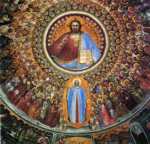Giusto de’ Menabuoi Biography
Giusto de’ Menabuoi (c. 1320-1391) was an Italian Early Renaissance painter from Florence.
Around 1348 he left Tuscany and traveled north, possibly to escape the Plague. Sometime during this period he moved to Milan, which was still free of the Plague at the time, where he was heavily influenced by the works of Giotto di Bondone. He executed several frescos in the Vibaldone Abbey in Giotto’s style, including one of The Last Judgment. These paintings were soon picked up by the local school as prime examples of art, raising Giusto to prominence.
He next moved to Padua around 1370, where his frescos in the Church of the Eremitani proved so impressive that they earned him Paduan citizenship in 1375. Giusto stayed in this city for the rest of his life, leaving behind other works, among these frescos in the Basilica of Saint Anthony of Padua (1382) and the Padua Cathedral, including his most notable painting, Paradise (1376).
Bibliography
Padua Baptistery of the Cathedral: Frescoes By Giusto De' Menabuoi XIV c. by Pietro Lievore. Editions G. Deganello, 1994.
- Paradise. Dome Frescoes.

c 1375-76. Fresco. Baptistery, Padua, Italy.